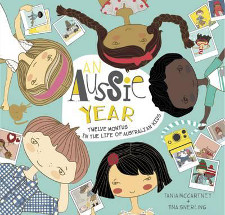An Aussie year by Tania McCartney

Ill. by Tina Snerling. EK Books, 2013. ISBN 9781921966248
(Age: K-3) Meet Ned, Zoe, Lily, Kirri and Matilda - five Aussie
kids from different
backgrounds who lead the reader on a journey through twelve months
of the
Australian year. Comprising cartoon-like vignettes with captions,
we follow the
children through the months and seasons as they celebrate what is
unique to them
and also what is common to all Australian children. From the slip,
slap, slop
of summer to back to school to the beginning of Ramadan the
enormous range of
cultures and ethnic backgrounds of our students are showcased
providing a dozen
different talking points on each double spread.
But the overwhelming theme is that of unity rather than diversity,
of similarity
rather than difference. Regardless of who your family is or where
they come
from, everyone enjoys fishing off the jetty in summer, going to
the footy in
winter, or getting ready for Christmas in December. This is a book
focusing on
our inclusivity and how our nation has melded together into a
multicultural one
in which the celebrations, food, and languages of others enriches
our lives and
adds extra layers to them. Each page offers the opportunity to
explore and find
out more - do huntsman spiders really grow as big as tennis
balls?; how can you
have a yacht race in Alice Springs?; what is daylight savings
time?; how do
other children celebrate Easter?
Apart from being a pictorial almanac of the things that Ned, Zoe,
Lily, Kirri
and Matilda do throughout the year, An Aussie Year lends itself to
a personal
interpretation as its theme and style could be the springboard for
a class
calendar as each student contributes something that is important
to them for
each month. Imagine how it engaging it would be if each child's
birthday was
featured on a page rather than a string of cardboard cakes with
candles that
loses its appeal very quickly. Imagine how much the children would
learn about
each other if each shared the things they liked to do or the
events that are
important to their family in a way that became an engaging read.
Imagine the
sense of belonging that each child would have as their heritage is
acknowledged
and celebrated and their classmates understood them a bit better.
Each month a
particular country could be highlighted with food and stories and
other
lifestyle elements as national days are celebrated. (There's a
list at
http://protocol.dfat.gov.au/NationalDay/list.rails)
Barbara Braxton